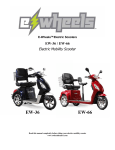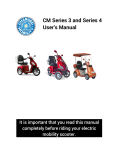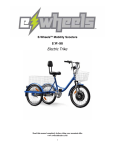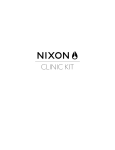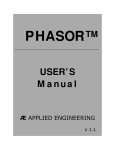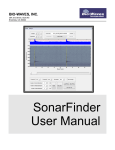Download Qelectric Expresso S Owner`s manual
Transcript
Electric Bicycle Owner’s Manual Read this manual completely before riding your Expresso. Q-Global Incorporated 374-A Encinitas Blvd, Encinitas, Ca 92024 27 Contents WARRANTY Foreword ……………………………………………… 2 Riding Safety ………………………………………….. 2 · Safety Basics …………………………………………. 3 · Operating Reminders and Suggestions …….. 4 · Wet Weather Riding …………………………….. 5 · Night Riding …………………………………………. 6 · Other Reminders …………………………………… 7 Specifications …………………………………………. 8 Components ………………………………………….. 9 Assembly and Setup ……………………………….. 11 · Head Tube Tightening …………………………… 11 · Cargo Box Mounting ……………………………… 12 Routine Operation ………………………………….. 14 Pre-Ride Check ………………………………………… 14 Steps to Startup ……………………………………… 14 Battery Care and Maintenance…………………. 16 Battery Charging …………………………………… DO NOT RETURN UNIT TO STORE OR DEALER For all Questions, Parts Requests or Technical Support please call Q-Global, Inc. directly. For Customer Service 866-402-1888 or 760-479-1888 8 AM – 5 PM PST Due to the nature and size of the product, Q-Global provides In Home Service on your Expresso. Please call us to set up a service call with a technician in your area. To ensure proper processing of all warranty claims, please return the enclosed warranty registration card along with a copy of the proof of purchase for the unit in question. 19 Other Maintenance …………………………………. 20 · Brakes and Tires …………………………………… 21 · Lubrication and Chain ……………………………. 22 · Scheduled Maintenance …………………………. 24 Troubleshooting ………………………………………. 25 Warranty ………………………………………………… 26 1 The Expresso is covered by a 6-month warranty. This warranty covers parts, and in some cases, labor or in-home service against factory defects. Failures caused by shipping damage, accident or misuse are not covered by warranty. 26 TROUBLESHOOTING GUIDE Problem Cause Battery gauge does not register anything when vehicle is on. 1. Loose connection near the power switch or battery pack. 2. Battery is completely discharged. 1. Motor wire is loose or disconnected. 2. Throttle is defective. 3. Controller is defective. Battery gauge registers but vehicle still does not work. Solution 1. Check the connections, reconnecting any that are loose. 2. Charge the battery. 1. Send to service to repair the wiring. 2. Replace Throttle 3. Replace Controller. 1. Adjust the chain. 2. Send to customer service to replace a new motor. Clicking noise coming from motor. 1. Chain is loose. 2. Magnets in motor have come loose. Vehicle does not stop when Throttle returns to original position. Controller or Throttle is defective. Replace Controller or Throttle. Customer service can assist in diagnosis. 1. Battery is low. 2. Defective battery. 3. Defective Throttle. 1. Tire pressure is low. 2. Battery is not fully charged. 3. Battery is damaged. 4. Headwind, slopes, overloading, etc. 1. Loose wiring near the charging socket. 2. Loose wiring in battery pack. 3. Defective Charger. 1. Charge battery. 2. Replace battery. 3. Replace Throttle 1. Fill Tires with sufficient pressure. 2. Charge battery for 6-8 hours. 3. Replace Battery 4. Reduce these factors. 1. Check the wiring, reestablish connection. 2. Send to a qualified service technician. 4. Replace Charger. Vehicle is losing speed. Distance per charge is reduced. Battery could not be charged. NOTE: if other problems occur, do not attempt to disassemble the electric bicycle on your own, please proceed to the bicycle dealer or to call Customer Service. 25 FOREWORD The Expresso is a highly stylish, environmentally friendly, fossil-fuel-free personal transportation device, incorporating these advanced-design components: Æ Highly efficient brushless DC motor. Æ Controller with battery indicator and protection from over voltage and under voltage. Æ Brake system with power cut-off, for safe riding. Æ 48V 14Ah high performance battery, delivering stronger current and longer range. Æ Front and rear suspension system providing a smooth and comfortable ride. Æ Front and rear tires are pre-charged with sealant, protecting against thorn punctures. RIDING SAFETY Like any sport, bicycling carries the risk of injury and damage. By choosing to ride the Expresso, you assume all responsibility for these risks. Thus, you need to know and practice the rules of safe and responsible riding. YOUR INSURANCE POLICIES MAY NOT PROVIDE COVERAGE FOR ACCIDENTS INVOLVING THE USE OF THIS BICYCLE. TO DETERMINE IF COVERAGE IS 2 PROVIDED YOU SHOULD CONTACT YOUR INSURANCE COMPANY OR AGENT. Safety Basics: Do’s and Don’ts The Do’s o Always conduct a Safety Check before you ride your Expresso. Be thoroughly familiar with the controls of your Expresso. o Always wear an approved helmet when riding your Expresso. Follow the helmet manufacturer’s instructions for fit, use and care of your helmet. o Always keep body parts and other objects away from the sharp teeth of chain rings; the moving chain; the turning pedals and cranks; and the spinning wheels of your Expresso. o Always wear shoes that will stay on your feet and will grip the pedals. o Wear bright, visible clothing that is not so loose that it can catch on moving parts of the Expresso or objects at the side of the road or trail. o Think about your speed, and keep your speed consistent with safe operating conditions. The Don’ts Scheduled Maintenance Expresso should be checked from time to time. Refer to the maintenance schedule in the following chart: check ● adjust ◆ change ▲ lubricate ■ Parts Bolts, nuts, screws etc-to ensure that nothing is loose. Footboard-to ensure it is not worn out Tire pressure-to ensure good tire pressure Chain drive equipment-to ensure chain is at good position; not too loose, nor too tight. Brake pads-to ensure it is not worn out. Wheel rim- to ensure it is not distorted. Steering Linkage- to ensure it is not distorted. Front light, bugle-to ensure functioning properly. Brake-to ensure it is working properly. Throttle- to ensure that it is working properly. Steering system-to ensure operation is normal. Wheel axle- to ensure if it is loose Motor-to see if it is working properly. 180 days daily 30 days ● ● ◆ ●■ ● ● ● ■ ●■ ● ● ◆ ●■ ● ◆ ●◆ ● ● ● ●■ ● ● ● ◆ ●◆ ● ■ ● ● ● ◆ ■ ◆ o Never ride with headphones. They mask traffic sounds, distract you from concentrating on your surroundings, and their wires can tangle in the moving parts of the Expresso, causing you to lose control. If you find problems that you cannot solve them yourself during your inspection and maintenance, please send your bike to your servicing dealer for help. Never take apart or repair the bike by yourself. If it causes any problem and voids the warranty, a service fee will be imposed. 3 24 4) When proper chain tension is achieved, tighten the axle nuts and re-secure the rear brake housing to the frame. If the chain needs to be taken off from the Expresso, for instance for rear tire replacement, be sure to re-orient the chain properly when put it back on. If the chain ever falls off spontaneously, this indicates either a mis-alignment of the sprockets, or a lack of proper chain tension. Cleaning 1) Never wash the bike using high-pressure water, as it will cause damage to the electric bike. 2) Never use lubricant to clean the metal parts of the bike and never apply lubricant to the drum brake and the tire. o Never carry a passenger. The maximum carrying capacity is 300 lbs. o Never ride barefoot or wearing sandals. o Don’t jump with your Expresso. It puts great stress on everything from frame and forks to cranks and pedals. Riders who insist on jumping their Expresso risk serious damage to their Expresso as well as to themselves. o Never carry anything which obstructs your vision or your complete control of the Expresso or which could become entangled in the moving parts of the Expresso. o Never hitch a ride by holding on to another vehicle. o Never ride your Expresso while under the influence of alcohol or other drugs. o If possible, avoid riding in bad weather, when visibility is obscured, at dusk or in the dark, or when you are very tired. Each of these conditions increases the risk of accident. o Never allow children to ride. Never allow others to ride without reading and understanding these instructions. Operating Reminders and Suggestions o Review all instructions carefully before riding the Expresso. o Follow all rules and regulations in your area for operating a motorized bicycle. Obey the same road 23 4 laws as all other road vehicles, including yielding the right-of-way to pedestrians, and stopping at red lights and stop signs. o Ride predictably and in a straight line. Never ride against traffic. o Use the signal lights to indicate turning or stopping. o Ride defensively. To other road users, you may be hard to see. o Concentrate on the path ahead. Avoid potholes, gravel and dirt, wet road, oil, curbs, speed bumps, drain grates and other obstacles. o Be alert for unexpected events, such as opening car doors or cars backing out of concealed driveways. o Be extra careful at intersections and when preparing to pass other vehicles. o Familiarize yourself with all the bike's features. Practice signal lights, braking and use of the horn. The changing method of the front tire is the same as common bicycle. It is more complex to change the rear tire because of the motor and brake assemblies, and associated wiring and cabling. If you are not comfortable with undertaking this operation, you can ask your servicing dealer or mechanic to change it. Lubrication You should inspect and maintain your Expresso and lubricate the mechanical power transmission components, and chain. The brake cables may also need lubrication Lubricate the brake cables with silicone or graphite lubricant. Maintenance period: one month. Lubricate the fork Shock Absorber tube, axle rim, and the axle ball bearing with SH/T0386 lubricant, bicycle or lithium grease. Maintenance period: one year. Chain Adjustment Adjusting the chain o Don't carry packages or passengers that will interfere with your visibility or control of the bike. Don't use items that may restrict your hearing. 1) Put the Expresso up on its Kickstand. o Maintain a comfortable stopping distance from all other riders, vehicles and objects. Safe braking distance and forces are subject to the prevailing weather and road conditions. 3) Adjust the nuts on the chain-tensioners (eyebolts). Turning the nuts clockwise will pull that side of the axle rearward, tightening the chain. The nuts should be adjusted together, so that the rear wheel is aligned with the direction of travel, and so that the two chain sprockets remain parallel. Wet Weather Riding 5 2) Loosen the rear axle. Loosen the fasteners for the rear brake. 22 Expresso after each ride. You should charge your Expresso if it has not been used for 30 days or more. WARNING Do not place the battery near heat or fire. Do not expose the chargers to water. OTHER MAINTENANCE Your Expresso should be returned to your servicing dealer or bicycle/scooter mechanic once a year for a thorough inspection and adjustment. This can guarantee the comfort, safety and the normal operating life of the Expresso. Front and Rear Brakes The adjustment of the front brake is the same as in a common motorcycle. It is very important to brake effectively and to be sure that the battery shut-off device is in good condition. When the brake lever is released, the wheel should spin without resistance. If it drags, it will waste a lot of electric power. You should change the brake’s shoes when they are worn to one-third of their original thickness. The rear drum brake is very similar to the brakes on electric scooter products. When this brake is exhausted, a squealing sound will be heard upon brake application. Front and Rear Tires 21 Wet weather impairs traction, braking and visibility, both for the rider and for other vehicles sharing the road. The risk of accident is dramatically increased in wet conditions. In wet weather you need to take extra care. In wet conditions, the stopping power of your brakes (as well as the brakes of other vehicles sharing the road) is dramatically reduced. This makes it harder to control speed and easier to lose control. To make sure that you can slow down and stop safely in wet conditions, apply your brakes earlier and more gradually than you would under normal, dry conditions. Decrease your riding speed, avoid sudden braking, and take corners with additional caution. Keep in mind that there is a direct, but inverse, relationship between speed and controllability. Be more visible on the road. Wear reflective clothing and use safety lights. Potholes and slippery surfaces such as lane markings and train tracks all become more hazardous when wet. Night Riding A rider is very difficult for motorists to see at dusk, at night, or at other times of poor visibility. If you must ride under these conditions, check and be sure you comply with all local laws about night riding; follow the Rules of the Road, and take the following precautions: Make sure that your Expresso is equipped with correctly positioned and securely mounted reflectors. Make sure your clothing or cargo does not obstruct a reflector or light. Ensure that the front lights are on. 6 Wear light colored, reflective clothing and accessories, any reflective device or light source that moves will help you get the attention of approaching motorists, pedestrians and other traffic. Ride slowly. Avoid hazards, such as potholes and curbs. Avoid areas of heavy traffic, dark areas, and roads with speed limit over 35 mph. If possible, ride on routes already familiar to you. Ride at night only if necessary. Slow down and use familiar roads with street lighting, if possible. Other Reminders The Expresso works best on level ground. Use caution while going down an incline, such as a hill or a ramp. Hill climbing and repeated acceleration/braking will exhaust the battery much more rapidly. The Expresso has an electrical brake cutoff system. When you engage either brake, the throttle becomes inoperative. Release the throttle before braking. Do not “ride” the brakes. The battery does NOT require deep discharging. If your Expresso is put into storage, re-charge its battery at least once every 90 days. Do not store your Expresso in direct sunlight for an extended time. Store your Expresso in a dry place. Exposing your Expresso to rain, snow, or other precipitation may result in damage. 7 3) Keep the charger(s) and battery away from water to prevent electrical shock and shorting. The charger(s) is intended for indoor use only. 4) Plug the end of the 2 charger’s cords into the sockets of the adaptor first. Next connect the adaptor to the Expresso. Then plug the chargers’ AC cords into the wall outlet. 5) Read the charger label to learn about the chargers’ indicator lights, and their meanings. 6) Generally, a short drive will require a short time to re-charge, and a long ride will require a longer time. A complete (90%) discharge may require 6 hours to recharge. To prevent electrolysis (battery fluid loss by hydrogen generation,) do not charge for longer than eighteen hours. 7) ALWAYS CONNECT BOTH CHARGERS WHEN RECHARGING. Before riding the electric bike for the first time, you must charge the batteries for 4-6 hours using the supplied 2 chargers. To charge, pull the protective cover from the charging sockets. Then plug the charger into the charging sockets, and plug the chargers into a wall outlet. IMPORTANT The electric bike is powered by four 12V/14Ah batteries wired in series to provide 48 volts of potential. All batteries charge simultaneously. You should charge your 20 Frequent braking and acceleration, driving into headwinds, up hills or with cargo will all cost a lot of battery energy. In these conditions, the Expresso will not reach its normal range. Battery Charging Be sure to charge the battery completely if you will not use it for a long period. Ideally, you should charge it every 20 days. Even a healthy battery will discharge itself slowly. Even with its power off, the Expresso Battery state-of-charge will decline gradually over time. Remember to fully charge the battery before your first ride. The battery may be low when you receive your new Expresso. 1) While charging the Battery, keep the key switch OFF. SPECIFICATIONS Product size (L x W x H): 71” x 27” x 43” (180 × 68 × 107 cm) Net Weight: 145 lbs (66 kg) Carrying capacity: 300 lbs (136 kg) Maximum range: 35 miles (56 km) Maximum speed: 19 mph (30.5 km/h) Motor type: Brushless Motor power: 500W Battery: 48V 14 Ah Battery type: Sealed lead acid battery Battery cycle life: Approximately 300 cycles Charger input: AC 110V Charging time: 2-6 hours Charger output: 50V/1.8A Tire size: 16 x 3.0 2) Verify that you are using the correct charger(s) for your vehicle, and that the charger(s) input power is compatible the “house current” in your area. 19 8 COMPONENTS Replace the battery if there are leaks, visible breaks or cracks. Dispose of used batteries by taking them to a recycling center, or according to state and local laws. Battery Temperature Sensitivity Ambient temperature will affect almost every kind of battery. Usually, the battery shows good discharging capability at higher air temperature. When the air temperature is under 0 ºF, the battery power will decline more than one third. So it is natural that the Expresso will not reach its normal mileage in winter or in cold weather. When the air temperature is up to 68 ºF, the Expresso will achieve its normal range capability. When the ambient temperature is over 110 ºF (as when exposed to summer sunshine for a long period), batteries and other electric components usually run in an abnormal fashion. 1. Headlight 7. Under-seat storage lock 2. Instrument Panel 8. Cargo Box 3. Ignition Switch 9. Luggage Rack • Rider weight: 180 lbs 10. Tail light • Air temperature: 77 ºF 11. Service stand • No headwind, smooth, level road, infrequent braking and steady speed. 4. Battery Box (under mat) 12. Side stand 5. Charger ports 13. Front brake adjuster 6. Seat with storage 9 What Does “Maximum Range” mean? To determine the Expresso’s maximum per-charge distance, the testing environment was: Under these conditions, the Expresso’s maximum range is up to 35 miles. 18 What’s Inside Your Expresso Battery The Battery is composed of four 12 Volt, 14 Amp-hour capacity batteries, in series, for a total capacity of 48 V, 14 Ah. The component batteries are a standard, commercially available size. Keep three things in mind, however, should you choose to service your battery. 1) The batteries are soldered into place. Replacing batteries will require soldering equipment and skills. 2) Batteries can be extremely dangerous. If allowed to short-circuit, they can cause burns, create blinding arcs, or explode, causing serious injury. If you accept this risk, work slowly, and exercise utmost care! Work with only one wire at one time. 3) Batteries, solder, and soldering vapors contain lead, a toxic substance that can build up in your body. Minimize your exposure to lead by wearing gloves, providing good ventilation when soldering, and washing hands after soldering or handling batteries. You should NEVER simultaneously solder and eat snack foods! 1. Brake lever 2. High/low beam selector 3. Rearview mirror Battery Trouble 4. Instrument Panel Should a battery ever leak, do not touch the battery liquid. If you are exposed to the solution, flush the affected area with water. If you must handle the battery, wear disposable gloves. 5. Rearview mirror 6. Headlight switch 7. Throttle 8. Ignition switch 17 Battery Care and Maintenance ASSEMBLY AND SETUP If your Expresso was removed from its carton and “set up” by retail store personnel, there is no guarantee it was properly set up. Please observe and follow this checklist, even if your Expresso was out of its carton when you purchased it. This will ensure its safe and reliable operation. 1) Remove your Expresso from its shipping carton. The Expresso weighs about 145 lbs, so get help, and use care. Cut away any residual packing materials with a sharp knife or scissors. Tools needed for setup are included in the Expresso tool kit. 2) Inflate the front and rear tires to 35 psi. 3) To make sure the alignment is correct, stand in front of the vehicle, using both legs to hold the front wheel in straight-forward position. Use both hands to grab the handle bar and turn it into normal driving position (90 degree angle from the front wheel). 4) Locate the Cargo Box. Find 4 bolts and 4 washers for mounting the box onto rear frame. What to Expect of Your Batteries, Ideally The battery is a sealed lead-acid type, with a gel electrolyte. With normal use, it can last for well over 300 charge/discharge cycles. Know that normal use should mean partial, and not complete discharging. If you employ “shallow” discharge cycles, using less than 30% of battery’s capacity, the battery can achieve up to 1,200 charge/discharge cycles. Thus, it is good to charge the battery after each ride. A partial discharge will require less time on the chargers. What to Expect, Realistically The battery can keep its performance for about 200 charge/discharge cycles, with high current and deep (80%) discharging. The storage capacity of the battery will decline after 200 times recharging. If you re-charge the battery before it is exhausted, you dramatically extend the battery’s cycle life. In Summary Always try to recharge the Battery Pack within 24 hours after use to maximize battery cycle life and prevent damage. A B 11 C 16 3) The Expresso has an onboard Voltmeter, indicating the Battery’s approximate state-of-charge. It is normal for this reading to “sag” somewhat during acceleration. Excessive Voltage “sag” is a sign of a depleted or damaged battery. When a battery is exhausted, if you force it to supply energy, it will dramatically damage the battery. At this time, the low-voltage protector will shut off the power automatically, protecting the battery from further damage. 4) Hold onto the handlebars with both hands. Assume a well-balanced position on the scooter and push off with your foot. Your right hand will control the accelerator. Twist the accelerator slowly to avoid a sudden rush of speed forward. The speed of the bike will increase as you twist the accelerator more. Release the accelerator and apply the brakes to stop your bike. You will control the speed of the bike by using both the accelerator and the brakes. When the brake handle is squeezed it cuts power to the accelerator. 5) Give the Expresso some acceleration and speed by first using your feet, then apply the throttle. Try not to brake and accelerate needlessly. When you drive against a wind or up an abrupt slope, use your feet to give the Expresso additional power. 6) Return the key to the OFF position and take out the key after riding, to secure your property and to save battery power. 15 5) Put the 4 bolts and washers into the pre-drilled holes at the bottom of box (A), and through the cargo rack. Thread the nuts on from below the cargo rack (B). Use a screwdriver to tighten the bolts, holding the nuts below with a wrench (C). To avoid breaking the ABS material of the box, do not over-tighten the bolts. 6) To lock the cargo box, insert the key (different from ignition key) and turn it counter-clockwise to the vertical position. To open the box, turn the key clockwise into the vertical position. 7) Attach the Rear View Mirrors to the mounting holes. A wrench can be used to tighten the lock-nuts at the base of each mirror. 8) Check if the brakes are properly adjusted. The brake handles should stop short of touching the hand-grip, when fully engaged. The rear brake cable can be adjusted in two places: 12 • At the cable end bracket, just before the lever, with 8 and 10 mm wrench adjustments, and • At the end of the lever, with a 10 mm nut fastener. The front brake is adjusted at the end of the cable, at the saddle nut. ROUTINE OPERATION A) Pre-Ride Check 1) Be sure the tires have enough air. Low tire pressure risks rim pinching (tube failure) and lowers your range (distance per charge). 2) Be sure the battery is fully charged. Riding on a low state-of-charge will reduce range, and can damage the battery. 3) Verify the proper adjustment and function of the brakes. 9) Check that the crank and rear chain sprockets are aligned, and that the chain has proper tension. Proper chain tension allows for a slight (±½ inch) movement up and down, when pulled with fingers at the point between the sprockets. Lubricate the chain with chain or lithium grease, not with a spray oil. 10) Your Expresso has been in transit and storage. You must charge the batteries before riding it. Charge the battery by plugging in the 2 included charger cords into the Expresso’s Charger Ports. 4) Make sure the Expresso is in good mechanical order. Visually inspect and hand-check the vehicle, and snug any loose bolts, screws, or other fasteners. 5) With the Expresso on its Kickstand, turn the key switch and apply the throttle, to verify the motor’s smooth operation. Apply the brake to stop the motor. Verify that the throttle is inoperative when either brake is applied. B) Steps to Startup 1) Roll the Expresso off its Kickstand. Mount the Expresso. Adjust the Rear View Mirrors so that you can see clearly behind you. 2) Insert the key into the key switch and turn the key from OFF to ON. 13 14














